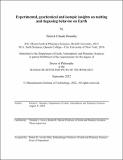Experimental, geochemical and isotopic insights on melting and degassing behavior on Earth
Author(s)
Beaudry, Patrick Claude
DownloadThesis PDF (97.98Mb)
Advisor
Grove, Timothy L.
Terms of use
Metadata
Show full item recordAbstract
This thesis investigates igneous and geothermal processes on Earth through various lenses and at various scales. The processes addressed range from fluid circulation in hydrothermal systems to the formation of the continental crust, onset of subduction, degassing of arc magmas, and mantle melting at mid-ocean ridges. Through this unlikely “medley” of Earth Science problems, parallels are drawn between experiments investigating melting and degassing at high pressure, geochemical and isotopic fingerprints of the Earth’s oldest rocks, and kinetic processes associated with aqueous supercritical fluids. The main lines of investigation rely on the tools of experimental petrology (Chapters 2 and 3) and stable isotope geochemistry (Chapters 1 and 4). Chapter 1 explores the systematics of methane (CH4) isotopologues in geothermal systems, with a particular focus on the kinetics of isotopic exchange reactions in the vicinity of the supercritical point of water (373°C and 220 bars). This study finds that CH4 isotopologues uniquely record high-temperature processes, given their high closure temperature—i.e. slow equilibration timescales under typical geothermal conditions—combined with the fast timescales associated with supercritical fluids. Chapter 2 describes the development of a new piston cylinder experimental approach to study the solubility and speciation of sulfur (S) in hydrous, oxidized primitive magmas as can be found in subduction zones. High pressure experiments demonstrate the coupled behavior of H2O and S, which mutually interact to fix redox conditions. Exsolution of S-rich fluids is found to play an important role on magmatic redox conditions, with apparent preferential loss of oxidized S to a fluid phase, explaining several natural observations from arc environments. Chapter 3 confirms the primary nature of a high MgO, high Al2O3 mid-ocean ridge basalt (MORB) glass from the ultraslow spreading Southwest Indian Ridge, identifying its multiple saturation boundaries within the plagioclase lherzolite stability field. This finding validates newly developed quantitative petrogenetic models for MORB, with important implications for our understanding of mantle thermal structure and for the origin of primitive glasses globally found at mid-ocean ridges. Chapter 4 describes the multiple S isotope characteristics of a suite of mafic to felsic rocks from the 4.0–2.9 Ga Acasta Gneiss Complex (AGC) from the Northwest Territories, Canada. These help placing constraints on the early Earth S cycle and its relation to tectonic regime. Along with other geochemical indicators, the Acasta rocks appear to record a gradual onset of subduction-like processes, established at least by ~3.3 Ga.
Date issued
2022-09Department
Massachusetts Institute of Technology. Department of Earth, Atmospheric, and Planetary SciencesPublisher
Massachusetts Institute of Technology